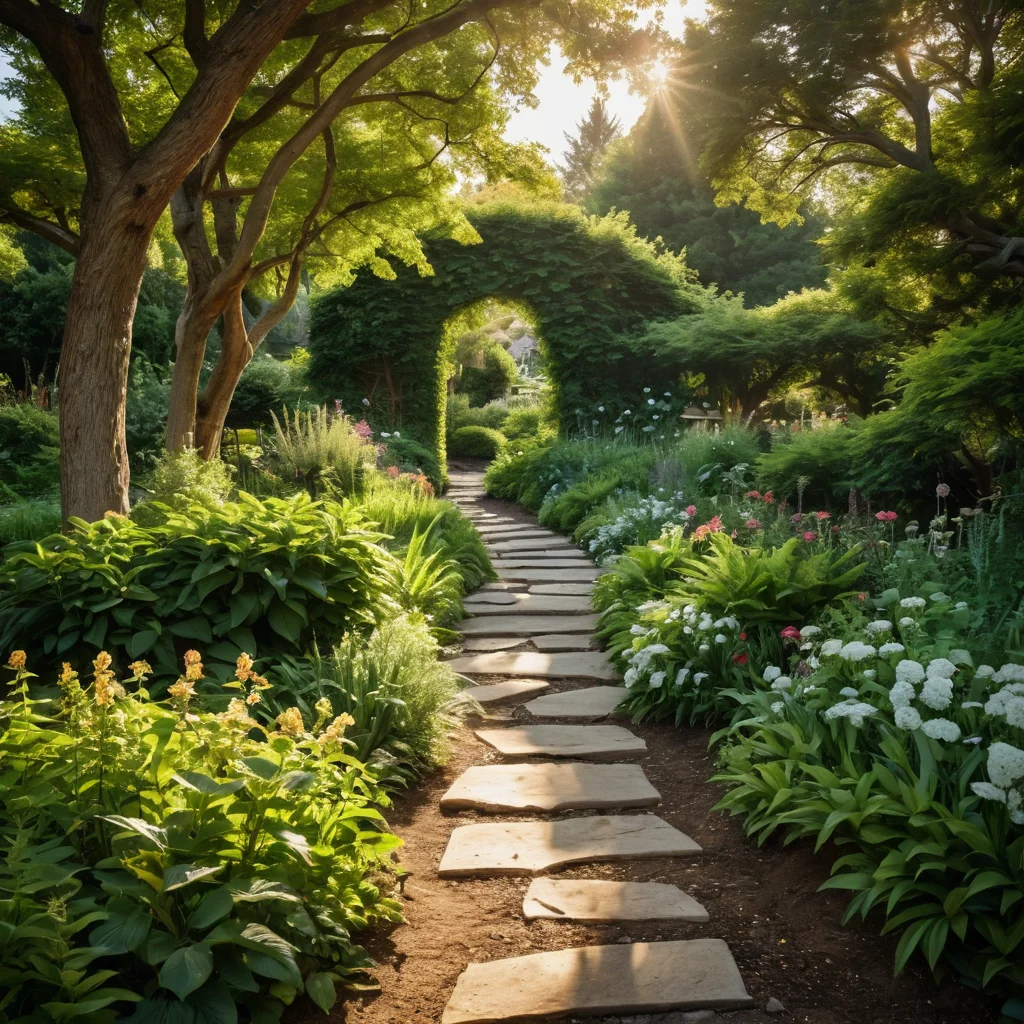Close your eyes and imagine. You are standing barefoot on soft, slightly damp grass. The morning mist gently touches your skin, and the air is filled with the subtle, incomparable aroma of blooming peonies and freshly cut greenery. Somewhere in the distance, birds chirp softly, and a light breeze sways the tree leaves, creating a soothing rustle. This is not just a beautiful landscape; it is your garden, awakening all your senses. Welcome to the world of the “Garden of Five Senses” – a place where every moment is filled with harmony, beauty, and tranquility.
What is a “Garden of Five Senses” and Why Do You Need One?
Have you ever wondered why some places evoke a storm of delight in you, while others leave you completely indifferent? Often, it’s about how these places affect our senses. A “Garden of Five Senses” is not just a trendy landscape design concept, but a thoughtful approach aimed at engaging all our sensory organs: sight, hearing, smell, touch, and even taste. It’s about creating a space that is not only visually appealing but also offers a whole spectrum of sensations, enriching our lives and bringing true enjoyment.
Why do we need such a garden? There are many reasons:
- For Health and Harmony: The modern pace of life often disconnects us from nature. A “Garden of Five Senses” becomes an island of calm where you can restore your energy, relieve stress, and find inner balance. By stimulating all senses, such a garden helps us fully immerse ourselves in the moment, forgetting about everyday worries.
- For Inspiration and Creativity: A beautiful and multifaceted garden is an inexhaustible source of ideas. It can be the perfect place for morning meditation, evening reading, or simply for sitting in silence and thinking. Even the simplest elements – the murmur of water, the scent of flowers, silky leaves – can awaken your imagination.
- For Child Development: Children learn about the world through sensations. A “Garden of Five Senses” is a true natural laboratory where young explorers can safely study plants, listen to nature’s sounds, touch different textures, and even taste edible berries and herbs. This teaches them to appreciate and care for nature.
- For Creating a Special Atmosphere: Imagine how pleasant it will be to invite guests to a garden where every corner is filled with a special magic. Fragrant flowers, pleasant-to-touch plants, and soothing sounds – all this creates a unique atmosphere of coziness and hospitality.
- For Enhancing Quality of Life: Spending time in a garden that engages all your senses literally allows you to live life to the fullest. It’s an opportunity to enjoy every moment, feel connected to nature, and discover new facets of beauty.
Creating a “Garden of Five Senses” is an engaging process that allows you to express your individuality and transform an ordinary plot into a true work of art. It doesn’t have to be expensive or complicated. The main thing is to approach it with heart and attention to detail.
How the “Garden of Five Senses” Affects Emotions and Well-being: A Scientific Perspective

Our senses are not just receptors that perceive the external world. They are directly linked to our emotions, mood, and even physical state. The “Garden of Five Senses,” by engaging them comprehensively, can have a profound healing and harmonizing effect.
Sight: Observing the vibrant colors of flowers, the play of light and shadow, and the flowing lines of plants calms the nervous system. Studies show that contemplating green and blue hues reduces stress levels and blood pressure. A beautiful garden is a form of visual therapy, helping to distract from worries and find peace of mind.
Hearing: The sounds of nature, such as birdsong, the murmur of a stream, and the rustling of leaves, have a soothing effect on us. They drown out city noise and create an atmosphere of relaxation. Natural sounds help reduce stress hormones and improve concentration. Conversely, harsh and unpleasant sounds can cause irritation and anxiety.
Smell: Aromas play a huge role in our emotional state. The scents of flowers, herbs, and trees can evoke pleasant memories, stimulate creative thinking, and even improve mood. For example, the scent of lavender is known for its calming properties, while the scent of roses can evoke feelings of joy and love.
Touch: Touching soft leaves, smooth tree bark, cool water, or warm stone gives us a sense of connection with nature. Tactile sensations help us ground ourselves, feel alive, and be present in the moment. Studies show that pleasant tactile sensations can reduce anxiety and improve well-being.
Taste: The ability to enjoy fresh berries, fragrant herbs, or ripe fruits straight from the garden is not only a pleasure but also beneficial for health. The taste of fresh, natural products awakens our taste buds and provides a sense of satisfaction. Consuming your own, lovingly grown food brings a special sense of pride and joy.
Thus, a “Garden of Five Senses” is not just a beautifully designed space, but a purposefully created environment that has a comprehensive positive impact on our physical and emotional health. It is an investment in your own well-being and quality of life.
Visual Harmony: How to Create a Garden That Pleases the Eye
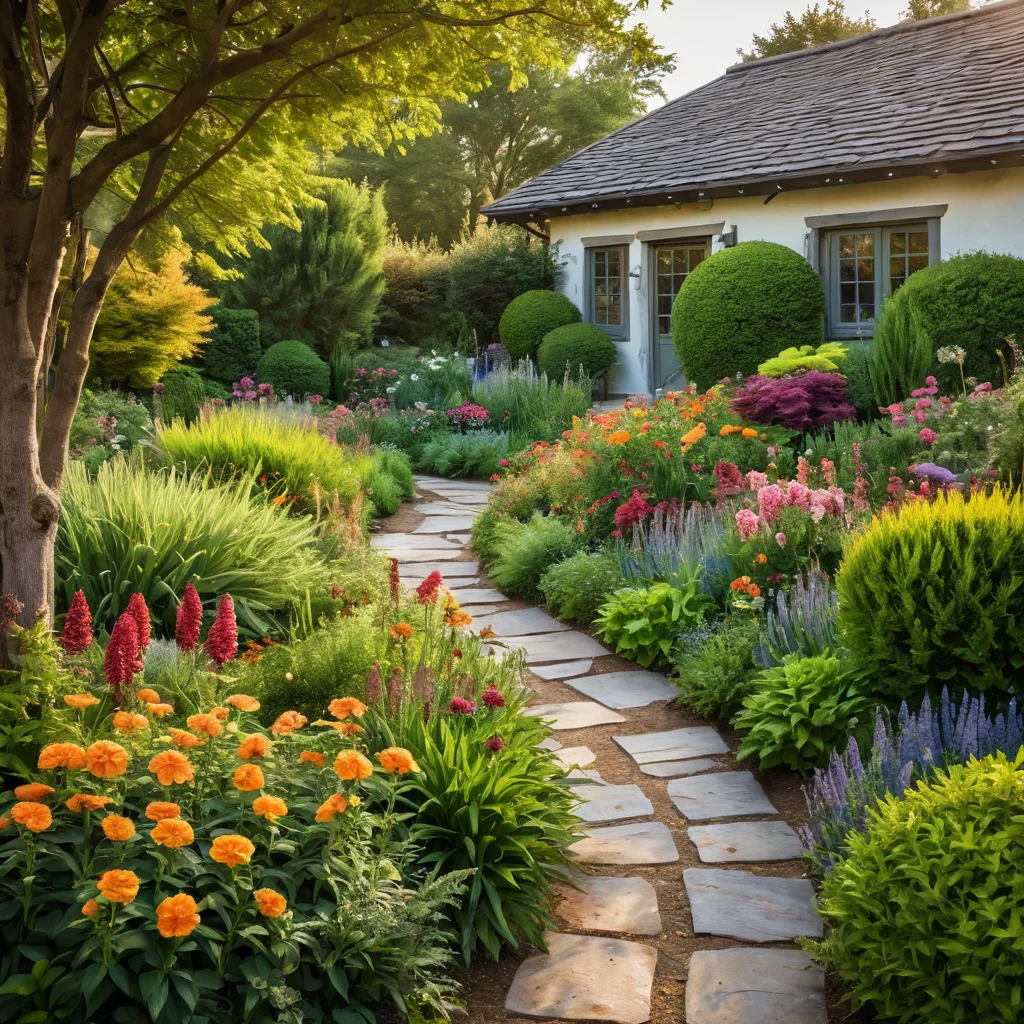
The visual aspect is perhaps the first thing we notice when entering a garden. Properly chosen plants, their shapes, colors, and textures, as well as thoughtfully arranged decorative elements, can transform a plot beyond recognition. My task is to share with you the secrets of creating a garden that will please the eye all year round.
Color Palette:
- Choosing a Color Scheme: Think about which colors you prefer. Do you want to create a calm, soothing space with a predominance of green, blue, and white shades? Or do you prefer bright, energetic compositions using red, orange, and yellow? You can also opt for a monochrome palette, for example, a garden in lilac and purple tones.
- Seasonality: It’s important for the garden to be pleasing to the eye not only in summer but also in other seasons. For spring blooms, choose bulbs (tulips, daffodils, hyacinths), forsythia, and cherry trees. In summer – roses, peonies, lilies, hydrangeas. In autumn, decorative grasses, asters, helenium, and the changing colors of tree foliage will adorn the garden. In winter, evergreens, tree bark, and snow patterns will bring beauty to the garden.
- Contrasts and Harmony: Combine plants with contrasting colors to create accents. For example, bright red roses will look striking against dark green foliage. At the same time, use harmonious combinations, such as different shades of pink and lilac, to create a delicate and refined composition.
Shapes and Textures:
- Variety of Shapes: Combine plants with different leaf and crown shapes. Lush, rounded shrubs (e.g., spirea, ninebark) perfectly complement slender vertical plants (decorative grasses, hostas with elongated leaves).
- Play of Textures: Rough, textured leaves (e.g., Hosta ‘Sum and Substance’) can contrast with small, delicate ones (like those of ferns, astilbe). Use plants with glossy and matte foliage to add depth to the garden.
- Vertical Accents: Don’t forget about vertical elements. These can be tall trees, shrubs, trellises with climbing plants, or even just curved branches left for winter. They give the garden volume and structure.
Composition and Structure:
- Layout: Plan the arrangement of flower beds, paths, and seating areas. Avoid chaos. Strive to create flowing lines and harmonious shapes.
- Focal Points: Highlight a few key elements that will attract attention. This could be an unusual plant, a sculpture, a fountain, or a picturesque rock grouping.
- Space: Don’t overcrowd the garden. Leave open spaces for the eye to rest. This is especially important for small plots.
DIY Garden Decor Ideas:
- Figurines and Sculptures: Create your own fun gnomes, birds from plastic bottles, or concrete angels.
- Lighting: Use garlands, solar-powered lanterns, and LED strips to create a magical evening atmosphere.
- Stone Compositions: Assemble picturesque compositions from natural stones of various sizes and shapes.
- Painted Pots: Turn ordinary clay pots into bright art objects by painting them with acrylics.
Remember, the most important thing is your vision and love for details. Experiment, try new things, and your garden will surely become a source of visual delight.
Garden Scents: Choosing Plants That Bloom Fragrantly
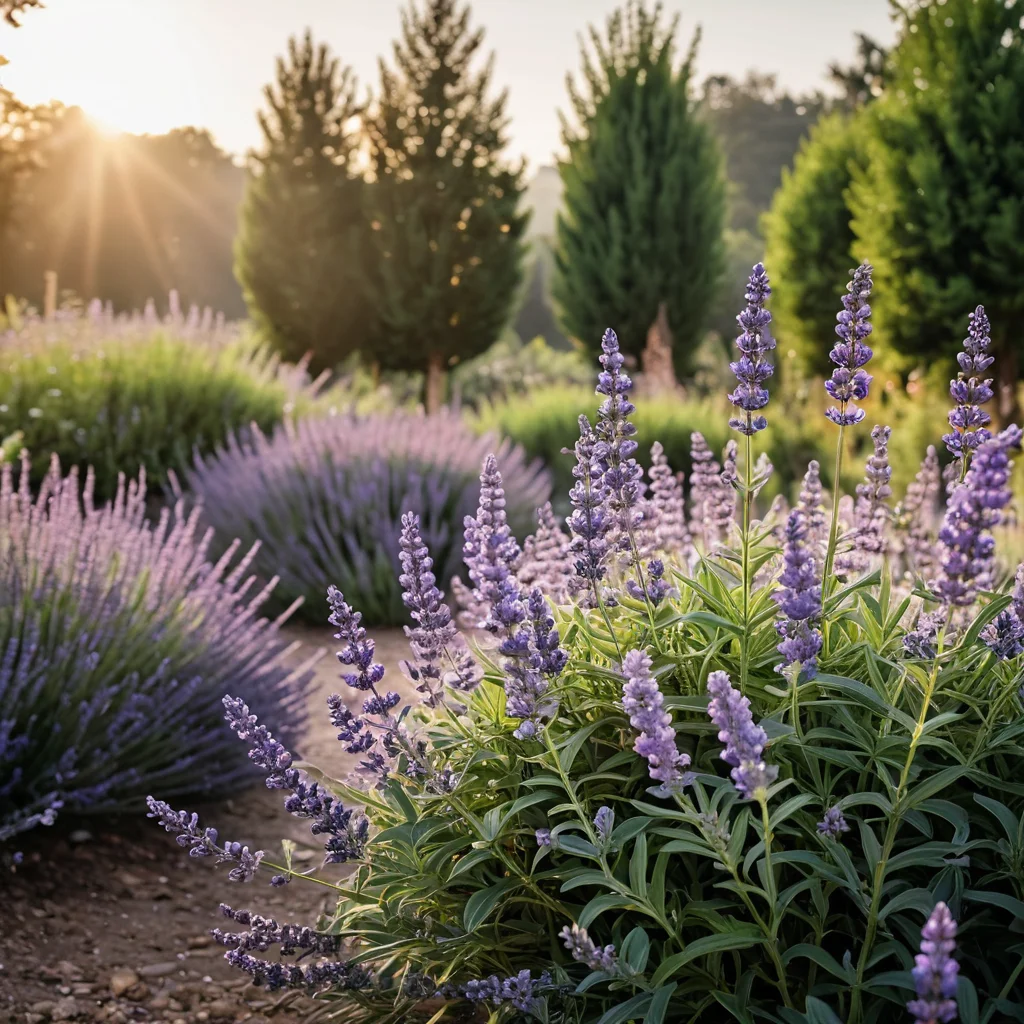
Scent is one of the most powerful emotions, evoking memories and influencing our mood. A “Garden of Five Senses” is unthinkable without fragrant plants that fill the air with subtle, intoxicating, or refreshing aromas. I always advise creating fragrant compositions so that the garden blooms throughout the season.
Spring Awakening of Scents:
- Lilac: A classic of the spring garden! Its dense, sweet aromas are associated with warmth and renewal. There are many varieties with different shades – from light lilac to purple.
- Lily of the Valley: A delicate yet very strong fragrance. It’s best planted in shady, moist areas.
- Hyacinths: Bulbous plants that offer bright, sweet aromas. They look great in mass plantings and containers.
- Mock Orange (Garden Jasmine): Its flowers, resembling jasmine, exude an exquisite, honey-sweet aroma.
Summer Fragrance:
- Roses: The queens of the garden, many varieties of which have an incredible aroma – from tart and spicy to delicate and fruity. Choose fragrant varieties, for example, ‘Aspirin Rose’, ‘Double Delight’, or old garden roses.
- Peonies: Luxurious flowers with diverse aromas – from light and fresh to rich and sweet. Believe my experience, the scent of peonies can create an atmosphere of a true celebration.
- Lavender: An incredible, calming aroma that is not only pleasant but also beneficial. Lavender flowers can be harvested and used for aromatic sachets.
- Lily: Especially Oriental hybrids, have a strong, exotic aroma. Plant them where their scent will be most noticeable.
- Honeysuckle (Caprifolium): A beautiful vine that emits a magical, sweet aroma in the evening. Ideal for vertical landscaping of gazebos and pergolas.
- Sweet Pea: An annual plant with a light, delicate fragrance. Great for cutting and decorating vertical supports.
Autumn Notes:
- Chrysanthemums: Some chrysanthemum varieties have a light, spicy aroma that adds a special charm to the autumn garden.
- Heather: The delicate flowers of heather, especially varieties with purple and pink blooms, create a pleasant, slightly tart aroma.
- Trees and Shrubs with Aromatic Bark or Leaves: For example, ornamental apples or some maple varieties can emit pleasant scents in autumn, especially in damp weather.
Practical Tips for Creating Fragrant Zones:
- Zoning: Create fragrant corners near relaxation areas – a terrace, a gazebo, a bench.
- Aroma Height: Combine plants of different heights. Low-growing flowers (lavender, alyssum) create aroma at ground level, medium-height plants (peonies, roses) – at human level, and tall ones (honeysuckle, lilac) – fill the air with aroma from above.
- Symphony of Scents: Choose plants with complementary aromas. For example, sweet aromas of roses and vanilla can harmonize well with fresher, citrus notes.
- Consider Wind Direction: Plant the most fragrant plants where the wind will carry their scent to your favorite resting spot.
- Flowering Time: Select plants so that the garden is fragrant at different times – from early spring to late autumn.
Don’t be afraid to experiment! Creating a fragrant garden is a true art that brings immense pleasure.
Sounds of Nature: How to Attract Birdsong and Rustling Leaves
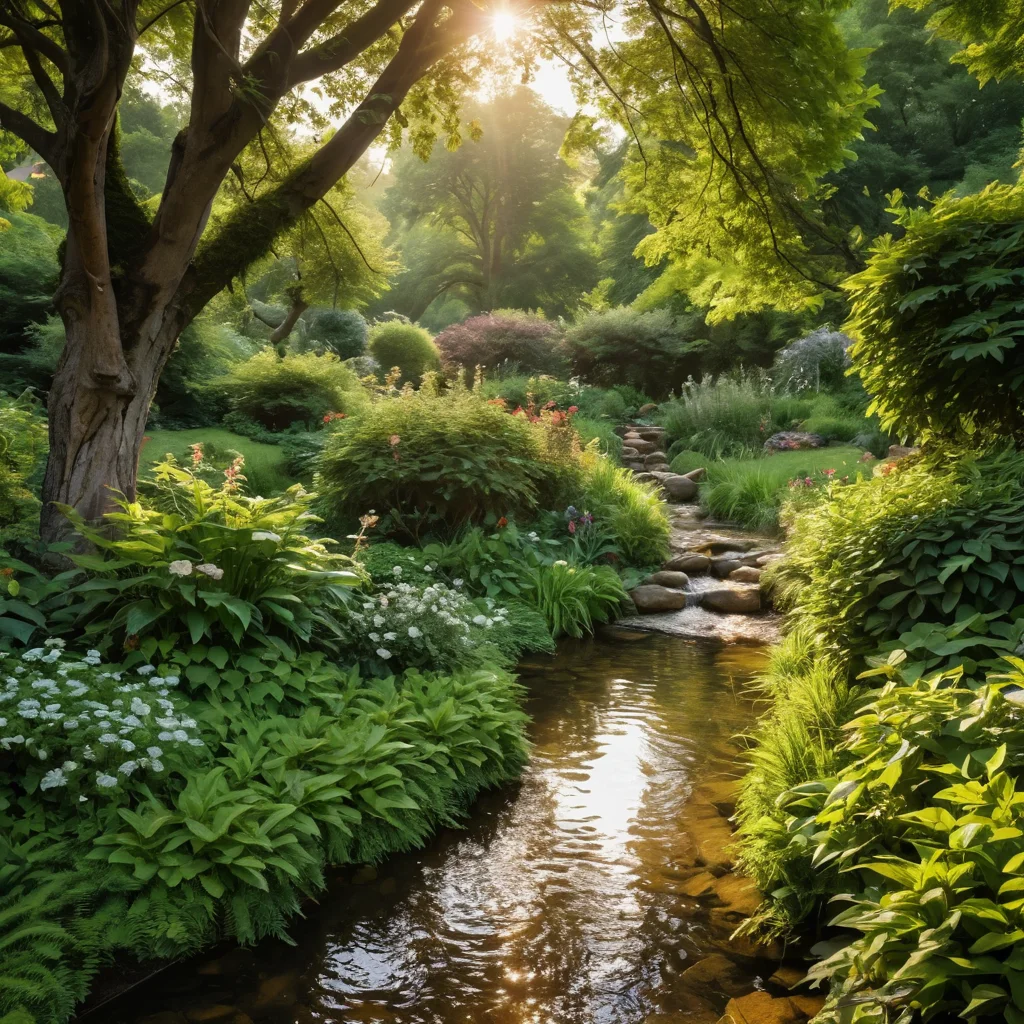
The soundscape of a garden plays a role no less important than its visual component. The soothing birdsong, the gentle rustling of leaves, the murmur of water – all these sounds can create an atmosphere of complete relaxation and harmony. How can you turn your garden into nature’s music box?
Attracting Birds:
- Feeders and Bird Baths: In winter and summer, place feeders with various food and shallow bird baths. Birds will appreciate the opportunity to feed and bathe in your garden.
- Dense Shrubs and Trees: Birds need places for shelter, nesting, and rest. Plant dense shrubs (e.g., hawthorn, rosehip, dogwood) and trees with dense crowns.
- Water Features: Small ponds or fountains attract not only birds but also other beneficial garden inhabitants, creating a pleasant sound background.
- Special Houses and Birdhouses: Place birdhouses and titmouse houses on trees to attract more feathered guests.
- Reduce Pesticide Use: Birds feed on insects. The more insects in your garden, the more birds you will attract.
Creating the Rustle of Leaves:
- Choosing Trees and Shrubs: Some plants produce a particularly pleasant rustle. For example, birch, aspen, linden, willow. Their thin leaves create melodious sounds in the wind.
- Planting in Groups: Trees and shrubs planted in groups enhance the rustling effect, creating a richer soundscape.
- Playing with Height: Combining trees of different heights and shrubs also contributes to creating an interesting sound landscape.
Water Elements:
- Small Stream or Waterfall: The murmur of water is one of the most calming sounds. Even a small stream or a cascade falling over rocks can transform the garden’s atmosphere.
- Fountain: Decorative fountains are an excellent option for creating pleasant sound accompaniment. Choose models with a quiet, melodious water sound.
- Pond: If space allows, a small pond with plants and perhaps even fish will be a source of calming gurgling and splashing sounds.
Silence and Solitude:
- Hedges: Dense hedges made of thuja, cotoneaster, or hawthorn not only serve as beautiful decorations but also absorb external noise, creating an island of silence.
- Rest Areas: Set up secluded nooks for relaxation where you can enjoy silence and the sounds of nature, protected from prying eyes and noise.
- Use of Natural Materials: Wooden benches, stone paths – these materials themselves are associated with nature and silence.
What to Avoid:
- Loud Garden Tools: Try to use manual tools where possible, or choose quieter electric alternatives.
- Unpleasant Sounds: Avoid plants with sharp, unpleasant odors or sounds (e.g., some types of dry grasses that can make an unpleasant rustle in the wind).
- Excessive Decorative Elements: Too many moving or jingling garden decorations can create excessive noise.
When creating your garden’s soundscape, remember harmony. The goal is not to drown out all sounds, but to complement the garden’s natural melody with pleasant chords.
Tactile Sensations: What Materials and Plants Are Pleasant to Touch
Touch is one of the oldest and most intuitive ways of knowing the world. In the “Garden of Five Senses,” tactile sensations play a special role, allowing us to feel a deeper connection with nature, ground ourselves, and find peace. I invite you to pay attention to the variety of textures your garden can offer.
Plants with Interesting Textures:
- Soft and Velvety:
- Lamb’s Ears (Stachys byzantina)
- Stachys
- Toadflax (Linaria)
- Smooth and Cool:
- Hostas
- Ferns
- Magnolia leaves
- Prickly and Interesting:
- Ornamental grasses (e.g., Blue Fescue)
- Spruces and Pines
- Roses
- Fragrant When Touched:
- Mint, Lemon Balm
- Lavender, Rosemary
Materials for Creating Tactile Zones:
- Natural Stone: Smooth river stones, rough boulders, cool slabs – stone offers a wide range of tactile sensations. You can create mosaic paths from small pebbles or use large stones for seating.
- Wood: Warm, smooth wood is an ideal material for benches, gazebos, and decks. Try to use unfinished but sanded wood to preserve its natural texture.
- Sand and Gravel: Areas covered with sand or small gravel invite barefoot walking. This is a great way to get new tactile sensations.
- Water: Even a simple touch of cool water in a fountain or pond provides pleasant sensations.
- Mulch: Bark, chips, wood shavings – these materials are not only beneficial for the soil but also pleasant to touch, especially if you enjoy working in the garden barefoot.
Creating Tactile Zones:
- Barefoot Paths: Designate a small area paved with different materials – sand, pebbles, soft grass, wooden rounds. Walking on such a path is a real pleasure!
- Sensory Play Areas: If you have children, create special areas for them with different textures: a sandbox, a water corner, a patch of soft grass.
- Decorative Elements: Use various textural elements in garden decor: woven baskets, carved wooden figures, rough ceramic pots.
Remember that tactile sensations should be pleasant and safe. Avoid sharp edges and rough materials that can cause injury.
Taste Notes: Edible Plants for Your Garden of Sensations

Creating a “Garden of Five Senses” is not only about beauty and fragrance but also about the opportunity to enjoy the taste of fresh, natural products straight from the garden. Integrating edible plants into your garden is a wonderful way to make it not only beautiful but also functional, and to add new, vibrant taste sensations.
Berry Abundance:
- Strawberries: They can be grown not only in garden beds but also in hanging baskets, containers, or as trailing varieties that will cascade beautifully.
- Raspberries and Blackberries: Choose everbearing varieties that fruit until the first frost. You can train them on trellises, creating a green wall.
- Currants and Gooseberries: Classic shrubs that not only yield fruit but also look great in hedges or as specimen plantings.
- Blueberries and Cranberries: These berries require acidic soil, but they are worth it – their taste and benefits are invaluable.
- Cornelian Cherry, Sea Buckthorn, Honeyberry: These less common but very beneficial berries will add variety to your garden.
Fragrant Greens and Herbs:
- Basil, Parsley, Dill, Cilantro: Plant them in beds, containers, or even directly in flower beds, creating vibrant green accents.
- Mint, Lemon Balm, Oregano: These herbs are not only fragrant but also great for making teas and refreshing drinks.
- Rosemary, Thyme, Sage: Mediterranean herbs grow well in warm, sunny locations and enrich dishes with a unique aroma.
- Lettuce Leaves: Various types of lettuce, arugula, spinach – all can be grown right in your garden for fresh, vitamin-rich salads.
Edible Flowers:
- Nasturtium: Its bright flowers and leaves have a pleasant peppery taste, reminiscent of mustard.
- Calendula: Its petals can be added to salads, soups, or used for garnishing dishes.
- Marigolds: Some marigold varieties have a pleasant citrus aroma and can be used in cooking.
- Violets and Pansies: These delicate flowers look beautiful in salads and desserts, adding an exquisite touch.
- Lavender: Lavender flowers can be used to flavor baked goods, drinks, or even added to meat dishes.
Fruit Trees and Shrubs:
- Apple, Pear, Cherry, Plum trees: The classics of any garden, which bring not only fruit but also beautiful blossoms in spring.
- Ornamental Apple Trees: Many varieties of ornamental apple trees produce small but edible fruits, which are excellent for making jam or compotes.
How to Integrate Edible Plants into the Design:
- Mixed Plantings: Don’t be afraid to plant edible plants alongside decorative ones. For example, fragrant herbs can look great in a rose garden, and berries among flowers.
- Vertical Gardening: Use climbing edible plants (e.g., beans, peas, cucumbers) to decorate pergolas, gazebos, and fences.
- Container Gardening: If your plot size is limited, grow greens, berries, and even some vegetables in pots and containers.
- Accent Beds: Create a beautiful, well-maintained bed with herbs or bright berries that will become a garden decoration.
Remember that good care, timely watering, and sufficient sunlight are crucial for a good harvest and vibrant taste. A “Garden of Five Senses” is an opportunity not only to admire beauty but also to enjoy the richness of flavors provided by nature.
Creating a “Garden of Five Senses”: Step-by-Step Guide and Common Mistakes
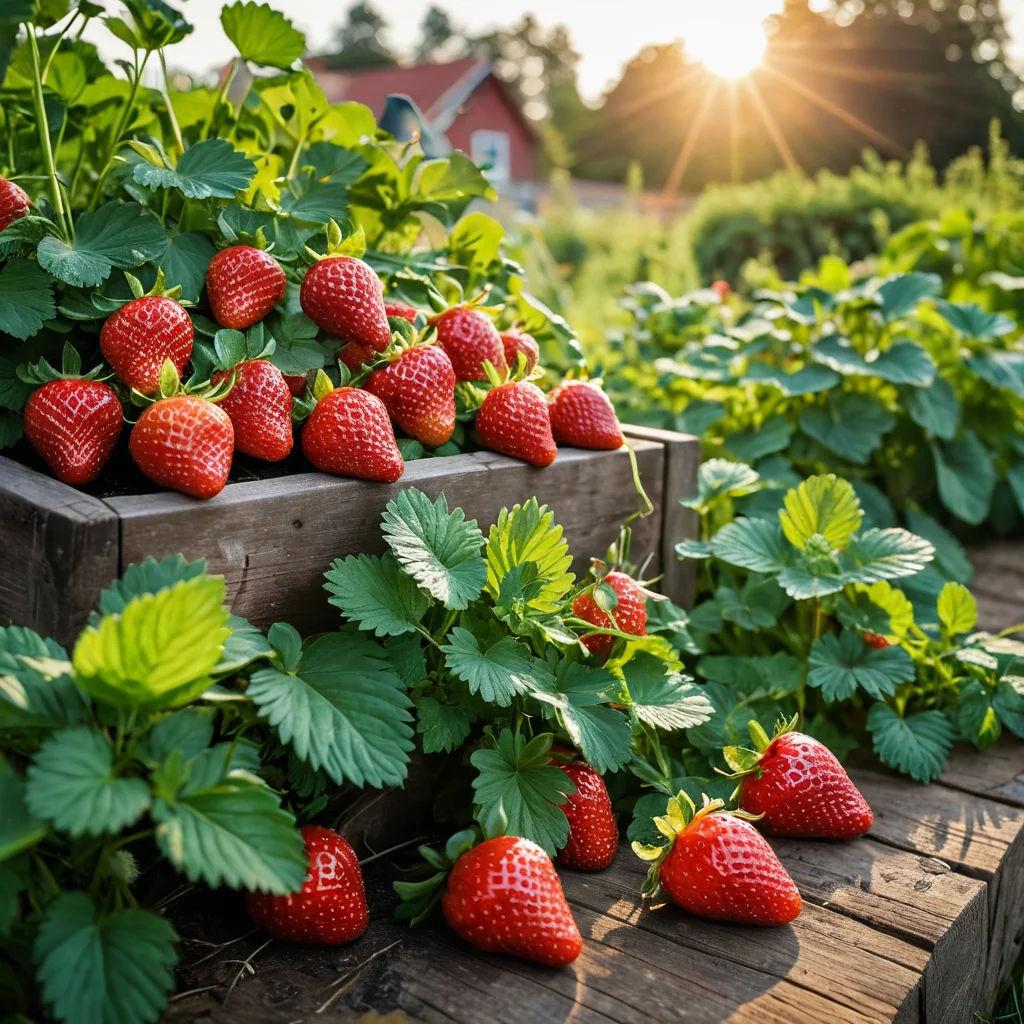
So, you’ve been inspired by the idea of a “Garden of Five Senses” and are ready to bring it to life. Don’t worry, it’s not as complicated as it might seem at first glance. The key is to approach the process creatively and systematically. I want to share a simple action plan with you and warn you about common mistakes so that your garden becomes a true oasis of harmony.
Step-by-Step Guide:
- Define Your Priorities: First and foremost, consider which senses are most important to you. Perhaps you want to create a garden with an emphasis on scents and sounds, or maybe tactile sensations and visual beauty are more important to you.
- Study Your Plot: Assess the sunlight, soil type, wind, and water conditions on your property. This will help you choose the right plants and materials.
- Create a Plan: Draw a rough plan of your future garden. Mark relaxation areas, flower beds, paths, water features, and spots for planting trees and shrubs.
- Work on the Visual Aspect:
- Select plants with different leaf shapes, colors, and textures.
- Create color compositions, considering the seasonality of flowering.
- Use decorative elements: sculptures, stones, lanterns.
- Fill the Garden with Scents:
- Choose plants with different flowering times and scent intensity.
- Create fragrant zones near relaxation areas.
- Add Sounds of Nature:
- Plant trees and shrubs that create a pleasant rustle.
- Install a small water feature or fountain.
- Attract birds with feeders and birdhouses.
- Enhance Tactile Sensations:
- Use natural materials: stone, wood, sand.
- Plant species with diverse leaf textures.
- Create barefoot walking paths.
- Integrate Taste Notes:
- Plant your favorite berries, herbs, and edible flowers.
- Use them in mixed plantings or create separate edible zones.
- Consider Lighting: The garden should be beautiful in the evening too. Use garden lanterns, garlands, and plant lighting.
- Regular Maintenance: A “Garden of Five Senses” requires constant attention. Water plants regularly, weed, and fertilize the soil.
Common Mistakes to Avoid:
- Overcrowding: Don’t try to fit too much into the garden. Less is often more. Avoid chaos and an excess of decorative elements.
- Ignoring Local Climate: Choose plants suitable for your climate, otherwise they will grow poorly or die.
- Incorrect Plant Selection: Before buying a plant, learn about its requirements for light, water, and soil.
- Lack of Balance: Ensure all five senses are harmoniously represented in your garden, and that one or two aspects do not dominate.
- Underestimating Maintenance: A beautiful garden is the result of constant effort. Don’t forget to care for the plants and the area.
- Ignoring Safety: Make sure all garden elements are safe for you, your loved ones, and pets. Avoid poisonous plants in areas accessible to children.
- Too Many “Noisy” Elements: An excessive number of moving or jingling decorations can disrupt the atmosphere of tranquility.
- Ignoring Seasonality: The garden should be attractive at any time of the year. Consider this when selecting plants.
Creating a “Garden of Five Senses” is a wonderful journey that will allow you to discover new facets of your plot and your own perception. Follow these recommendations, put your heart into it, and your garden will surely become a place where you can draw inspiration, relax, and feel truly happy.
